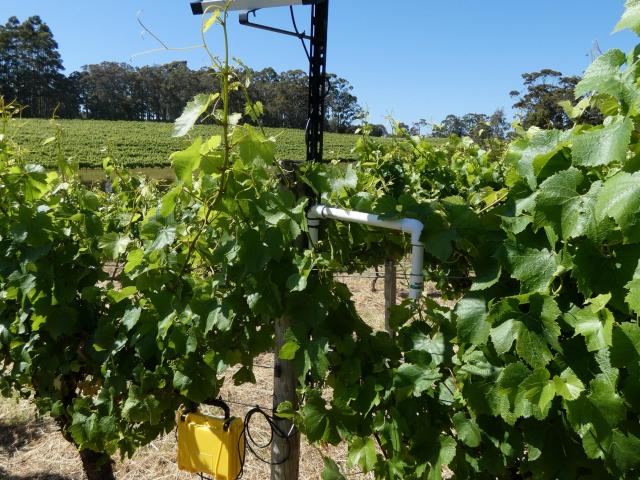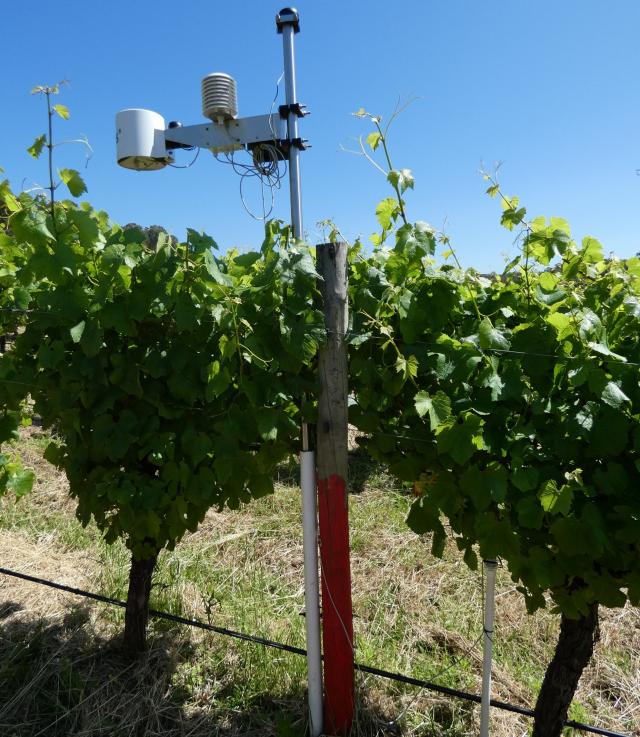Powdery mildew spore trapping and disease modelling
Last season, DPIRD's plant pathologist Dr Andrew Taylor undertook a preliminary project investigating the timing of powdery mildew spore release in WA vineyards by using spore traps to determine if these could be used to calibrate disease models developed in overseas regions.
As part of the project, rotor-rod spore traps were installed in 4 WA vineyards; 2 in Margaret River and 2 in vineyards in the Great Southern region. These spore traps were designed and optimised by researchers in Oregon, USA, who kindly provided details on their construction and assistance in the analysis of the rods.
The spore traps spin greased rods that capture airborne powdery mildew spores and have been found to detect powdery mildew before symptoms of the disease are observed by monitoring scouts. The spore traps were placed in vineyards in October, representing growth stages between EL7 (first leaf separated) and EL12 (5 leaves separated) of the various varieties in each of the vineyards.

Rods were replaced with freshly greased rods once a week. Due to what turned out to be a high bird pressure season, it was decided to remove the spore traps just prior to the Christmas period so not to interfere with any planned bird netting operations. This meant the spore traps were removed around EL31 (pea-size).
A spore trap was also installed at the DPIRD's research wine grape block in Manjimup, as this is known to have a high level of powdery mildew, to act as a positive control to the four commercial vineyards. As this site did not require bird netting this spore trap was operated into mid-January.
At the end of the season, DNA was extracted from each set of rods and sent off to the Mahaffee lab (USDA) in Oregon, to assess the amount of powdery mildew spores captured.
When the spore traps were being installed, DPIRD also installed weather stations within the same vineyards to collect important weather information for disease and vine development.
The weather stations (iMETOS 3.3) record a range of weather variables; temperature, humidity, wind direction and speed and leaf wetness, which is currently not recorded from the existing network of weather stations installed by BOM or DPIRD. Leaf wetness duration is an important parameter for the development of diseases and is a useful measurement for vineyard operations.
A suite of disease models are available as part of the installed weather stations software, and these were subscribed to last season as part of the project. Several disease models for powdery mildew are included in the subscription, one for ascospore release, one developed in California, known as the Thomas/Gubler model and a further general model. The Gubler/Thomas powdery model focusses on the associated temperature range for infection risk, whereas the ascospore and general model include leaf wetness, temperature, and humidity to calculate potential risk.
After analysis of the 4 commercial vineyards, powdery mildew was detected at 2 sites in very low numbers as early as November, with no resistance mutations detected. The detection occurred over several weeks and in some instances, this was as low as one spore recorded.
At the Manjimup research site, detected spore numbers rose exponentially from 1 November until the trap was removed in the middle of January. Resistance mutations for the QoI (Group 11) fungicides were also detected at this site for the first time, interestingly these mutations were at a higher frequency late in the season, coinciding with the increase in spore counts. Group 11 fungicides have rarely been used for grape powdery mildew management at the site, so examination of spray history is being conducted to understand how this detection occurred.
The lack of detections in the commercial vineyards in most instances coincide with the disease risk potential from the models for the period of time the spore traps were in place (Figure 1).

However, it also indicates the spore traps were removed too early to gain meaningful calibration data to determine whether they would reliably predict risk in WA vineyards. It also indicates the early season management programs at all the commercial vineyards were efficient enough to maintain low levels of powdery mildew, to prevent an epidemic level of outbreak at the back end of the season.
The study has highlighted several important factors to be considered before conducting similar projects.
- The spore traps can detect very low numbers of spores prior to visual detection and are therefore a useful surveillance tool.
- However, to gain meaningful spore numbers across a block several spore traps are required for coverage.
- For complete calibration, the spore traps would need to be placed in the blocks over several seasons to account for different weather conditions faced.
- Unsprayed, check or control vines would need to be present in the block for scouting to pick up visual signs of infection for the calibration to be successful.
- Leaving unsprayed vines in commercial vineyards can be a management risk, so research blocks may be required in the first instance for calibration data to be established in WA.
This project was conducted under the regional program funded by Wine Australia, so is not a multi season project. However, the weather stations, purchased by DPIRD, have not been removed from the vineyards and this data continues to be available.
For producers interested in viewing the data, the Field Climate website is accessible using the login details below. A field climate app is also available from app stores which allows access to the weather data from your smart phone.
User: DPIRDHORT
Password: DPIRDweather22
The benefit of the spore traps used in this project is that they are cheap to produce, a YouTube video is available on how to construct them as they are commonly used in viticultural areas in America. Unfortunately, at present there are no commercial laboratories in Australia offering the service of analysing the rods for the level of powdery mildew spores.
We would like to thank the participating vineyards for hosting the weather stations and spore traps and the Mahaffee lab in Oregon for processing the rods and assistance in constructing the spore traps, and acknowledge funding from Wines of WA via the Wine Australia Regional Program.

